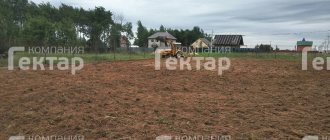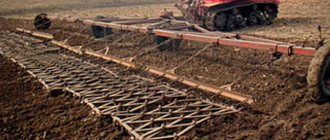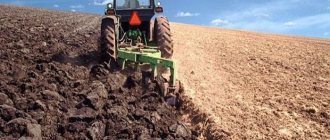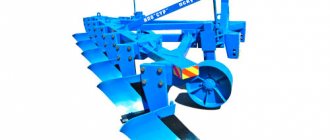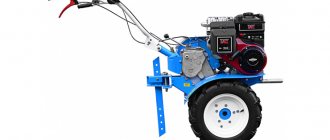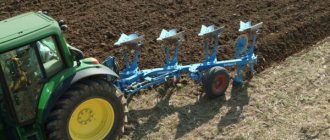The tool for plowing the soil is the plow. The purpose of the equipment is to deeply loosen the soil, which provides the basis for preparation for sowing crops and the further process of cultivating them. This land-cultivating device is characterized by working with the highest energy consumption among all other types of loosening devices (harrows, cultivators) as part of units.
High-performance trailed reversible arable unit
Types of plows
Among the loosening devices, depending on the nature of soil cultivation, there are the following types of plows:
- Dump
- Dumpless
- Special
The first two categories relate to agricultural devices and are used for basic soil cultivation. The devices differ from each other in the nature of loosening, where the first ones provide plowing with the rotation of the soil layer, and the second (non-moldboard) cultivate the fertile layer without turning it over.
Plow body
Working paw of a bladeless flat cutter
Chisel rippers
The category of special plows includes devices designed for reclamation operations or wandering in the development of areas after logging. The working bodies of such devices correspond to the nature of the tasks performed. The example below shows a universal device that provides, during readjustment: uprooting, cutting fire furrows, hilling.
Working parts of a universal forestry plow
Aggregation of plows
According to the nature of the connection with the tractor, plows differ in:
- mounted
- semi-trailer
- semi-mounted
- trailed
Mounted - attached rigidly to the three-point hitch of the aggregated machine, the entire mass of which in the transport position falls on the tractor chassis. The implement is transferred to the working and transport position by a hydraulic cylinder of the linkage as part of the hydraulic linkage system of the tractor. All mounted plowing implements have a small working width with no more than 8 ripper bodies in their design.
Semi-trailed and semi-trailed plows are connected through the tractor hitch hitch. To move the unit in the transport position, the plows are equipped with running wheels. Part of the plow's mass is distributed to the tractor's coupling device, and the other part is distributed to the running support wheels as part of the equipment.
Trailed plows are equipped with a chassis that carries the full weight onto its support wheels without exerting force on the tractor coupling.
Semi-mounted arable unit
Semi-trailer arable unit
Trailed arable unit
The translation of trailed and semi-trailer (semi-mounted) devices into the working position is carried out by hydraulic cylinders built directly into the design of the land-cultivating equipment. Such plows are characterized by high productivity and have from 6 to 12 working bodies. Considering the significant traction force required for the operation of such devices, arable units are formed with powerful energy-rich tractors of at least the 5th traction class.
Product design - main components
The basis of the plow consists of the following parts:
Frame – the base on which all its components are fixed;- The body is a solid cast stand with a blade, a plowshare and a field board attached to it;
- Skimmer - a small casing with a working surface used for the final embedding of plant residues;
- Support wheel - used for precise regulation of plowing depth, and its adjustment is possible due to a system of special marks printed on the stand;
- Hitch – provides connection between the tractor and the plow;
- Harrow hitch – is responsible for harrowing the surface, which takes place simultaneously with plowing.
Mouldboard and plowshare plows
Plows that perform plowing with formation turnover have a loosening body design in the form of a body with a cutting blade and a blade that turns the formation. Such devices are the most common and are widely used for basic soil cultivation.
Types of moldboard plows
Moldboard plows are divided into two categories:
1 General agricultural devices used for basic soil cultivation. This category includes mounted and semi-trailer and trailed devices, both single-body and multi-body tillage devices.
PLN-3-35 with angle marks on dumps
2 Planting plows are used for deep cultivation (from 50 cm to 100 cm) when restoring soil fertility, plowing before planting orchards and vineyards, and when carrying out reclamation activities. The design of the device is a powerful hinged body with a blade for deep loosening. The operation of such devices is characterized by mixing the upper and lower soil horizons, opening access to moisture from the lower layers.
Planting PPN-100
In addition, there are cultivator plows with disc bodies, which have several universal functions in use. Such devices provide plowing with partial rotation of the formation, where the depth of processing is regulated by changing the angle of attack of the cutting discs.
Moldboard disc plow
Form of dumps
To achieve good quality plowing, depending on the physical condition of the cultivated soil, plow bodies for basic cultivation can be equipped with moldboards of various types and shapes. So, for equipping moldboard plows, there are four main types of moldboards:
- Cylindrical - in relation to the flow of the cut formation, the dump is placed steeply, as a result of which the formation bends sharply and crumbles when falling. Such a dump does not provide a complete rotation of the formation, but crumbles the soil well.
- Cultural - more curved than cylindrical, satisfactorily crumbles and turns over the layer. It is used in well-groomed areas with light soil composition.
- Half-screw - used in old arable and soddy areas; it wraps well around a layer with partial coloring.
- Screw - characterized by good turnover of the formation with poor crumbling, used in soddy areas.
Types of dumps for plowing with formation turnover
Among the innovative modifications of moldboard plows, one can note the introduction of feather-shaped moldboards in the form of a split plane, which makes it possible to improve the crushing of a moving soil layer, or the equipping of dumps with “angle skimmers”, in the form of metal plates, which ensure crushing of the layer and the formation of an even plowing topography. As well as the use of moldboard bodies made of a wear-resistant polymer composite, which are less susceptible to sticking of moistened soil and facilitate the overall design of the plow.
Three-furrow moldboard plow with feather mouldboards
Mounted PLN-4-35 with angle signs
Additionally, for effective incorporation of crop residues and good crushing of soil clods, moldboard plows can be equipped with skimmers in the form of a separate cutting plowshare installed in front of each body at ⅓ of the working depth of the main body. In the classification of plows, equipment with skimmers is called cultural plows.
Cultural plow
Reversible moldboard plow
To increase the productivity of arable units, the design of moldboard plows includes redundant bodies with a reverse direction of operation. If it is necessary to turn the unit, the hydraulically controlled turning mechanism in the plow changes the direction of plowing by changing the bodies. This design makes it possible to avoid the formation of stall and camber furrows in the plowing horizon, reduce fuel consumption and time for turning the unit, since with the function of changing the direction of operation of the bodies, it is unnecessary to divide the field into pens, and the movement of the unit is carried out according to a shuttle pattern.
Reversible five-furrow plow with feather mouldboards
Six-furrow reversible moldboard plow at work
Models of moldboard plows
Among the models of moldboard plows, there are devices for machines from the smallest traction class (walk-behind tractors and mini-tractors) to high-performance ones, when coupled with energy-rich heavy-duty tractors.
Examples of deciphering the abbreviations of moldboard plow models:
PLN 5-35 – mounted ploughshare plow, 5-hull, with a body grip width of 35 cm. PNO 3-35 (PON 3-35) – mounted reversible 3-hull, body grip 35 cm PLP 7-30 – trailed ploughshare, 7- mi cabinet, with a body grip width of 30 cm.
PLONU 8-40 is a mounted, reinforced 8-hull plowshare, with a body grip of 40 cm. PPO 9-35 is a trailed reversible 9-hull, with a body grip of 35 cm.
Additionally, in the designations of moldboard plows, the manufacturer may indicate the type of installed moldboards or an additional letter indicating the specialization in the use of the device. For example:
PBN-3-50A - swamp mounted 3-hull, with a body width of 50 cm, PLB-1 - swamp-shrub single-hull plowshare
Table of main models of moldboard plows
| Plow model | Working width, m / Capacity, ha per hour | Tractor traction class, t.p. |
| PLN 1-35 | 0,35/0,2-0,3 | 0.2-0,6 |
| PLN 2-35 | 0,7/0,35-0,65 | 0,9-1.4 |
| PLN 3-35 | 1,05/ 0,74-1,05 | 1.4 |
| PNO 3-35 | 1.05/O.72-0.94 | 1.4-2 |
| PLN 4-35 | 1,4/ 0,98-1,26 | 2-3 |
| MON 4-35 | 1,4/1-1,3 | 3 |
| PLN 5-35 | 1,75/1,22-1,57 | 3 |
| MON 5-35 | 1,75/1,28-1,6 | 3 |
| PLN 6-35 | 2.1/ to 1.9 | 3 |
| PLN 7-35 | 2,45/2,45 | 4-5 |
| PLN 8-35 | 2.8/ up to 2.8 | 4-5 |
| PPO 7-35 | 2,45/2,2-2,5 | 4-5 |
| PLP 8-35 | 2,8/2,8 | 4-5 |
| PLNU 8-40 | 3,2/3,2 | 5 |
| PLP 9-35 | 3,15/3,15 | 5-6 |
| PP 9-35 | 3,15/3,15 | 5-6 |
| PP 10-35 | 3,5/3,5 | 6-9 |
| PP 11-35 | 3,85/3,85 | 6-9 |
| PP-12-35 | 4,2/4,2 | 6-9 |
| PPO-12-35 | 4,2/4,2 | 6-9 |
Final adjustment – adjustment under operating conditions
Well, the adjustment is completed in the field.
After the first two passes, check the width and depth of the treatment. If the first body plows deeper than the rear one, lengthen the central link; otherwise, shorten it slightly. Distortions in the transverse plane are adjusted by adjusting the braces, and the grip width is adjusted by moving the suspension axis to the left or right along the guides. They also pay attention to the correct position of the central link - it should be in a parallel position with respect to the longitudinal axis of the tractor, with the limit chains freely lowered. When turning the plow in the direction of the arable field, move the axis forward along the left bracket, but if it moves to the left, move it back.
Moldless plows
The category of moldless plows includes subsoilers-flat-cutters and chisel rippers. Plowing with such devices is characterized by deep loosening of the fertile layer with minimal disruption of its upper part. This treatment helps protect the soil from wind erosion and drying out.
Mounted flat cutter KPG-2-150
The working parts of the flat cutter are made in the form of powerful pointed paws, ensuring loosening over the entire thickness of the horizon without disturbing the surface. Chisel plows are equipped with chisel-shaped rippers, which allow, together with effective loosening, at maximum depth, to destroy the compacted layer of the arable sole, ensuring the deepening of the arable layer and the supply of moisture from the lower layers.
Mounted chisel PCHN-4
The majority of models of moldless rippers require the creation of a significant traction force from the tractor for the unit to operate. Among the non-mouldboard devices on the market, the lowest traction force, as part of such an arable unit, requires a tractor of at least 2nd traction class and higher.
Trailed chisel wide-cut subsoiler
It should also be noted that there are models of plows with universal use, where, when converting working bodies, the ripper device can be used as a moldboard plow and a moldboardless ripper. An example of such a land-cultivating mounted machine is the high-speed combined universal plow - PSKu-5(6), which in the moldboard mode is equipped with screw blades, and in the non-mouldboard mode the blades are dismantled.
Mounted PSKu-5
Brands of flat cutters
Decoding the brands of flat cutters
KPG-2-150 cultivator flat-cutter deep-ripper with 2 working parts, with the grip of one lancet share 150 cm PGN-5 mounted flat-cutter-subsoiler with 5 cutting paws PGP-7 trailed flat-cutter-subsoiler with 7 cutting tines
Moldboard-less flat cutter ripper PGN 5
| Brands of flat cutters | Working width, m/productivity, ha per hour | Required traction force of the tractor, t.p. |
| KPG-250 | 2,5/1,08-1,35 | 3-4 |
| KPG-2-150 | 3.2/ up to 3 | 3-4 |
| PGN-3 | 3,2/3 | 3-4 |
| PGN-5 | 5,3/5,3 | 5-6 |
| PGN-7 | 7,4/7,4 | 5-6 |
| GGP-7 | 7,4/7,4 | 5-6 |
Chisel brands
Examples of deciphering the abbreviation of subsoiler chisels:
PCHN-4.5 mounted chisel plow with a working width of 4.5 m PCHG-3 chisel deep-ripper plow with a working reach of 3 m GCh-4 chisel deep-ripper with a working reach of 4 m PCH-3/1-6 – chisel plow with a working reach of 3 m, one row of working tools with 6 rippers PCH-4.5/2-9 – chisel plow with a grip of 4.5 m, two rows of working tools with 9 rippers
| Brands of chisel subsoilers | Working width, m/productivity, ha per hour | Required traction force of the tractor, t.p. |
| GRZ-1.5 | 1,5/0,8-1,2 | 2 |
| PCH-2/1-4 | 2/1,5 | 2-3 |
| PCH-2,3 | 2,3/1,5 | 2-3 |
| PCHN-2.5 | 2,5/1,8 | 2-3 |
| PCh-2.5/2-5 | 2,5/1,8 | 3-4 |
| PCHG-3 | 3/1,5-3 | 3 |
| PCH-3/1-6 | 3/1,5-3 | 3-4 |
| PCH-3.5 | 3,5/2,5 | 4-5 |
| PCh-3.5/2-7 | 3,5/2,5 | 4-5 |
| PCH-4/2-8 | 4/3-4 | 5 |
| PCHG-4.2 | 4,2/2-4,2 | 5 |
| PCH-4.5 | 4,5/3,5 | 5-6 |
| PCH-4.5/2-9 | 4,5/3,5 | 5-6 |
| GC-4 | 4/3,2-4,8 | 5-6 |
| PCHG-5.4 | 5,4/2,5-5,4 | 5-6 |
Preparing the walk-behind tractor for plowing
Tillage is a technological process that requires special training of motor vehicles and plows. First you need to transport the car to the field that needs to be processed. If you are using a lightweight walk-behind tractor, it can be transported in the back of a car. Before plowing, you need to perform daily maintenance of the machine and check its functionality.
During plowing, light and medium-class walk-behind tractors are equipped with lugs instead of wheels. They improve traction with the soil and increase the total weight of the equipment. Before installing the lugs, you need to transport the car to a level area, place a stop under the rear hitch and remove the wheels. If you can replace the hubs on a walk-behind tractor with longer ones to increase the track, then replace them. After this, the lugs are installed. Make sure that the tread pattern on the lugs is directed in one direction. The tapering of the pattern indicates the direction of movement.
After carrying out maintenance and replacing the wheels with lugs, you can begin connecting and adjusting the plow.
Special plows
This category of devices includes plows intended not so much for cultivating the soil, but for performing technological operations related to the formation of relief or soil cleansing, such as:
- uprooting roots and stumps
- hilling crops
- cutting irrigation, planting and fire furrows
Universal mounted forestry plow
In the design of these devices, there is no specific underlying system and nature of the work of the working body and processing. The cutting and loosening organs of special plows have a different appearance, with a shape and design that meets the specifics of the work being performed.
Rooter
PKL-70D forest uprooter-furrow cutter
Rooter
Homemade attachments
Almost any attachment for a tractor can be made independently. This could be a homemade potato digger, a homemade rotary mower (or haymaker), a rotary plow, a cultivator, or a hiller. Sometimes you can remodel some equipment to make it more functional.
The most popular queries in the search engine remain the design of an active plow on MTZ or DT and the question of how to make a cultivator with your own hands. After all, cultivators are faithful assistants to agricultural workers. The most complex element on MTZ or DT is the rotary cutter. A converted cultivator with a high-quality cutter can carry out hilling for a long time.
It is not difficult to understand how to install attachments, be it plows for tractors, a homemade cultivator, a potato digger for a tractor, or other homemade products. The main thing is to act according to the given algorithms and check the diagrams and drawings. In the same way, you can easily understand how to adjust the chisel plow of a wheeled tractor without any extra effort. Installing chisels on a wheeled tractor is a labor-intensive process, which can nevertheless be done by the tractor driver himself.

